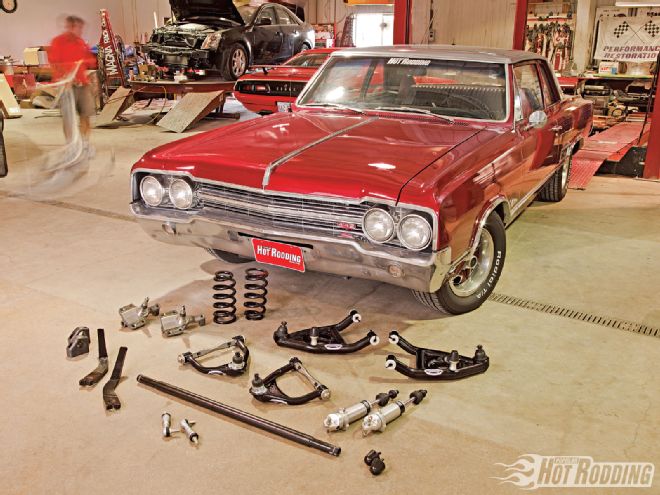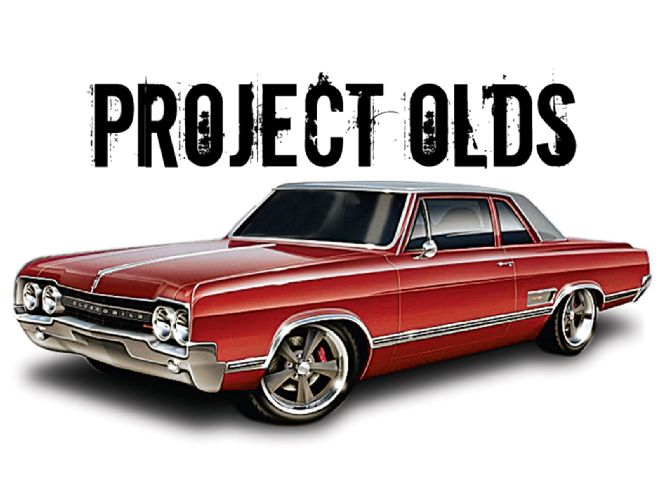
The art of engineering, unfortunately, is often a compromise dictated by the lowest common denominator. How else can you explain the existence of Macintosh computers, Jitterbug cell phones, and TiVo? The factory suspension design of a typical muscle car is no different. In retrospect, while it may seem like Detroit engineers of the '60s were absolutely clueless, they knew exactly what they were doing. With rippling big-blocks, squirmy bias-ply tires, and four-speed sticks shocking the driveline with each powershift, saving drivers from their own incompetence took precedence over trying to set new lap records at the Nürburgring. Spindles that pointed toward the wrong end of the car (forward) and front tires that gained positive camber as the suspension compressed were common tricks used to ensure loads of easy-to-manage understeer at the expense of sharp handling. Our '65 Olds Cutlass project car is no exception, and to fix what the factory intentionally messed up, we decided to install a complete Detroit Speed and Engineering front suspension system.

DSE's comprehensive Speed Kit 3 (PN 031326) includes tubular upper and lower control arms, forged drop spindles, coilovers, a splined sway bar, a quick-ratio steering box, and tie rods. When matched with the DSE four-link we installed last month, the result is a state-of-the-art suspension, designed and built to modern standards, that can fend off the most agile of autocross aggressors. Nevertheless, merely installing the parts is only half the battle. Maximizing the cornering potential of any chassis requires meticulously scaling, aligning, and corner-weighting the suspension. To help us get everything dialed in, stepping up to the plate once again is Brent Jarvis of Performance Restorations. Not only does Jarvis build Pro Touring muscle machines for a living, he's a diehard A-Body man who's been racing them since 1974. He's logged hundreds of miles on the road course and autocross behind the wheel of various A-Bodies over the decades, and drives to work every day in a big-block-powered '68 Chevelle-on R-compound tires! Here's a step-by-step outline of how to install a trick front suspension, and just as importantly, how to fine-tune the alignment and cornerweights in preparation for high-g combat.
Alignment
"To properly align a car, you first need to determine the real usage of the vehicle. It should always be done with the simulated weight of the driver in the car. McGaffin intends on driving his car a lot on the street and taking it to the autocross, but doesn't want to have to switch his alignment back and forth. I've been carefully monitoring tire wear on all the street and race cars that we build, and have come up with some great all-around specs that work well on a dual-purpose car like this Olds. On a setup like this, I like to dial in 1.5 degrees of negative camber, 6.5 degrees of positive caster, and set the toe-in 1/8 inch. I like a lot of caster for a couple reasons. It gives great steering wheel feel. It prevents the car from climbing the sides of uneven roads. It counteracts negative camber on the inside tire when turning, and increases negative camber on the outside tire when turning.
"After assembling the suspension, the caster and camber were almost perfect, while the toe only needed some minor adjusting to get it close. I only needed to remove one shim to tweak the camber and set the toe, and we were done. I see lots of guys camber in the front ends over 3 degrees and run toe out at the autocross, and while it does help the cornering a bunch, it will just grind the rubber off the inside edges of the tires when driving around town. There is always some give and take when it comes to alignment, however, my '68 Chevelle tips the scales at 4,000 pounds with me in it, and I've run these same specs as in the Olds for over 6,000 miles this summer. I've road raced, autocrossed, and drag raced on a set of R-compound tires, and they still have plenty of tread left." -Brent Jarvis
Tire Pressure
"Road racing and autocrossing A-Bodies for years has revealed that you need a huge difference in front-to-rear tire pressure. A-Bodies are front-heavy and almost always have smaller tires on the front. Consequently, we preset the tire pressures at 37 psi up front and 32 psi in the rear. Autocross will always use a little less air pressure than when road racing because you don't have the same high-speed lateral g-forces on the tires. Tire pressure is one of the best adjusting points on the car when on the autocross. As a general rule of thumb, if the car is experiencing oversteer, either lower the rear pressure or raise the front pressure. If the car is experiencing understeer, either raise the rear pressure or lower the front pressure. This is assuming you have the car dialed in fairly close to ideal, and you're watching the tires closely for even wear and heat transfer across the tread." -Brent Jarvis
Corner Weights
"After setting the alignment and tire pressure, the corner weights can be dialed in. If a car's corner weights are out of whack, you'll end up with a car that turns in one direction better than the other. That's because the tires and sway bars will be loaded unevenly. It makes a huge difference if you set up the corner weights right, and you will definitely turn faster lap times. That said, it is impossible to get any lefthand or righthand drive car perfect unless you build it from scratch with weight placement in mind. With the exception of a select few high-end sports cars, all cars are front heavy, with most of that weight biased toward the left side. The weight of the driver, steering wheel and column, steering box, brake master cylinder and booster, power steering pump, gauges, foot pedals, and sometimes the battery all add up to one big unbalanced mess. As a suspension tuner, it's our mission to get these weights as close as we can without making the car lean to one side or the other. The beauty of coilovers is that they allow you to fine-tune the corner weights, raising or lowering one corner of the car individually." -Brent Jarvis
PROJECT OLDS THE COST SO FAR Description: PHR Issue: Price: '65 Olds Cutlass Jan. 2010 $7,500 DSE four-link suspension Jan. 2010 $2,345 DSE front suspension Feb. 2010 $3,982 Total: $13,827